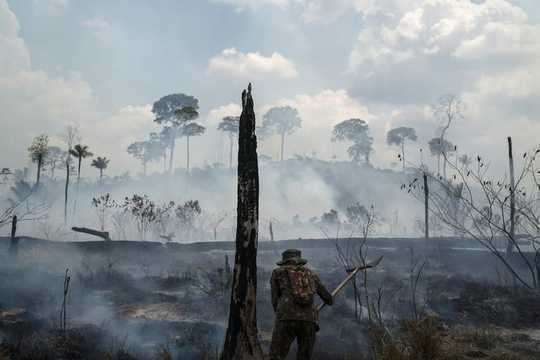
A Brazilian soldier puts out fires. AP Photo/Leo Correa
Growing up in Tanzania, I knew that fruit trees were useful. Climbing a mango tree to pick a fruit was a common thing to do when I was hungry, even though at times there were unintended consequences. My failure to resist consuming unripened fruit, for example, caused my stomach to hurt. With such incidents becoming frequent, it was helpful to learn from my mother that consuming the leaves of a particular plant helped alleviate my stomach pain.
This lesson helped me appreciate the medicinal value of plants. However, I also witnessed my family and neighboring farmers clearing the land by slashing and burning unwanted trees and shrubs, seemingly unaware of their medicinal value, to create space for food crops.
But this lack of appreciation for the medicinal value of plants extends beyond my childhood community. As fires continue to burn in the Amazon and land is cleared for agriculture, most of the concerns have focused on the drop in global oxygen production if swaths of the forests disappear. But I’m also worried about the loss of potential medicines that are plentiful in forests and have not yet been discovered. Plants and humans also share many genes, so it may be possible to test various medicines in plants, providing a new strategy for drug testing.
As a plant physiologist, I am interested in plant biodiversity because of the potential to develop more resilient and nutritious crops. I am also interested in plant biodiversity because of its contribution to human health. About 80% of the world population relies on compounds derived from plants for medicines to treat various ailments, such as malaria and cancer, and to suppress pain.
Future medicines may come from plants
One of the greatest challenges in fighting diseases is the emergence of drug resistance that renders treatment ineffective. Physicians have observed drug resistance in the fight against malaria, cancer, tuberculosis and fungal infections. It is likely that drug resistance will emerge with other diseases, forcing researchers to find new medicines.
Plants are a rich source of new and diverse compounds that may prove to have medicinal properties or serve as building blocks for new drugs. And, as tropical rainforests are the largest reservoir of diverse species of plants, preserving biodiversity in tropical forests is important to ensure the supply of medicines of the future.
Plants and new cholesterol-lowering medicines
The goal of my own research is to understand how plants control the production of biochemical compounds called sterols. Humans produce one sterol, called cholesterol, which has functions including formation of testosterone and progesterone - hormones essential for normal body function. By contrast, plants produce a diverse array of sterols, including sitosterol, stigmasterol, campesterol, and cholesterol. These sterols are used for plant growth and defense against stress but also serve as precursors to medicinal compounds such as those found in the Indian Ayurvedic medicinal plant, ashwagandha.
 Withania somnifer, known commonly as ashwagandha, manufactures molecules that could be useful for cholesterol medicine.. Wowbobwow12/Wikipedia, CC BY-SA
Withania somnifer, known commonly as ashwagandha, manufactures molecules that could be useful for cholesterol medicine.. Wowbobwow12/Wikipedia, CC BY-SA
Humans produce cholesterol through a string of genes, and some of these genes produce proteins that are the target of medicines for treating high cholesterol. Plants also use this collection of genes to make their sterols. In fact, the sterol production systems in plants and humans are so similar that medicines used to treat high cholesterol in people also block sterol production in plant cells.
I am fascinated by the similarities between how humans and plants manufacture sterols, because identifying new medicines that block sterol production in plants might lead to medicines to treat high cholesterol in humans.
New medicines for chronic and pandemic diseases
An example of a gene with medical implications that is present in both plants and humans is NPC1, which controls the transport of cholesterol. However, the protein made by the NPC1 gene is also the doorway through which the Ebola virus infects cells. Since plants contain NPC1 genes, they represent potential systems for developing and testing new medicines to block Ebola.
This will involve identifying new chemical compounds that interfere with plant NPC1. This can be done by extracting chemical compounds from plants and testing whether they can effectively prevent the Ebola virus from infecting cells.
There are many conditions that might benefit from plant research, including high cholesterol, cancer and even infectious diseases such as Ebola, all of which have significant global impact. To treat high cholesterol, medicines called statins are used. Statins may also help to fight cancer. However, not all patients tolerate statins, which means that alternative therapies must be developed.

Villagers take a break during a meeting of Tembé tribes at the Tekohaw indigenous reserve, Para state, Brazil. From the trees they take traditional medicines, as well as products they sell, such as acai, an Amazonian berry that’s a vitamin- and calorie-packed breakfast staple in Brazil. AP Photo/Rodrigo Abd
Tropical rainforests are medicine reservoirs
The need for new medicines to combat heart disease and cancer is dire. A rich and diverse source of chemicals can be found in natural plant products. With knowledge of genes and enzymes that make medicinal compounds in native plant species, scientists can apply genetic engineering approaches to increase their production in a sustainable manner.
Tropical rainforests house vast biodiversity of plants, but this diversity faces significant threat from human activity.
To help students in my genetics and biotechnology class appreciate the value of plants in medical research, I refer to findings from my research on plant sterols. My goal is to help them recognize that many cellular processes are similar between plants and humans. My hope is that, by learning that plants and animals share similar genes and metabolic pathways with health implications, my students will value plants as a source of medicines and become advocates for preservation of plant biodiversity.
About The Author
Walter Suza, Adjunct Assistant Professor of Agronomy, Iowa State University
This article is republished from The Conversation under a Creative Commons license. Read the original article.
Related Books
Life After Carbon: The Next Global Transformation of Cities
by Peter Plastrik , John Cleveland The future of our cities is not what it used to be. The modern-city model that took hold globally in the twentieth century has outlived its usefulness. It cannot solve the problems it helped to create—especially global warming. Fortunately, a new model for urban development is emerging in cities to aggressively tackle the realities of climate change. It transforms the way cities design and use physical space, generate economic wealth, consume and dispose of resources, exploit and sustain the natural ecosystems, and prepare for the future. Available On Amazon
The future of our cities is not what it used to be. The modern-city model that took hold globally in the twentieth century has outlived its usefulness. It cannot solve the problems it helped to create—especially global warming. Fortunately, a new model for urban development is emerging in cities to aggressively tackle the realities of climate change. It transforms the way cities design and use physical space, generate economic wealth, consume and dispose of resources, exploit and sustain the natural ecosystems, and prepare for the future. Available On Amazon
The Sixth Extinction: An Unnatural History
by Elizabeth Kolbert Over the last half-billion years, there have been Five mass extinctions, when the diversity of life on earth suddenly and dramatically contracted. Scientists around the world are currently monitoring the sixth extinction, predicted to be the most devastating extinction event since the asteroid impact that wiped out the dinosaurs. This time around, the cataclysm is us. In prose that is at once frank, entertaining, and deeply informed, New Yorker writer Elizabeth Kolbert tells us why and how human beings have altered life on the planet in a way no species has before. Interweaving research in half a dozen disciplines, descriptions of the fascinating species that have already been lost, and the history of extinction as a concept, Kolbert provides a moving and comprehensive account of the disappearances occurring before our very eyes. She shows that the sixth extinction is likely to be mankind's most lasting legacy, compelling us to rethink the fundamental question of what it means to be human. Available On Amazon
Over the last half-billion years, there have been Five mass extinctions, when the diversity of life on earth suddenly and dramatically contracted. Scientists around the world are currently monitoring the sixth extinction, predicted to be the most devastating extinction event since the asteroid impact that wiped out the dinosaurs. This time around, the cataclysm is us. In prose that is at once frank, entertaining, and deeply informed, New Yorker writer Elizabeth Kolbert tells us why and how human beings have altered life on the planet in a way no species has before. Interweaving research in half a dozen disciplines, descriptions of the fascinating species that have already been lost, and the history of extinction as a concept, Kolbert provides a moving and comprehensive account of the disappearances occurring before our very eyes. She shows that the sixth extinction is likely to be mankind's most lasting legacy, compelling us to rethink the fundamental question of what it means to be human. Available On Amazon
Climate Wars: The Fight for Survival as the World Overheats
by Gwynne Dyer Waves of climate refugees. Dozens of failed states. All-out war. From one of the world’s great geopolitical analysts comes a terrifying glimpse of the strategic realities of the near future, when climate change drives the world’s powers towards the cut-throat politics of survival. Prescient and unflinching, Climate Wars will be one of the most important books of the coming years. Read it and find out what we’re heading for. Available On Amazon
Waves of climate refugees. Dozens of failed states. All-out war. From one of the world’s great geopolitical analysts comes a terrifying glimpse of the strategic realities of the near future, when climate change drives the world’s powers towards the cut-throat politics of survival. Prescient and unflinching, Climate Wars will be one of the most important books of the coming years. Read it and find out what we’re heading for. Available On Amazon
From The Publisher:
Purchases on Amazon go to defray the cost of bringing you InnerSelf.comelf.com, MightyNatural.com, and ClimateImpactNews.com at no cost and without advertisers that track your browsing habits. Even if you click on a link but don't buy these selected products, anything else you buy in that same visit on Amazon pays us a small commission. There is no additional cost to you, so please contribute to the effort. You can also use this link to use to Amazon at any time so you can help support our efforts.

























